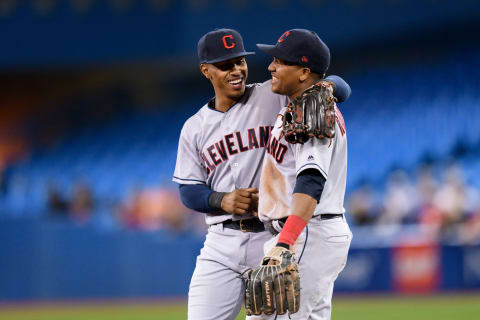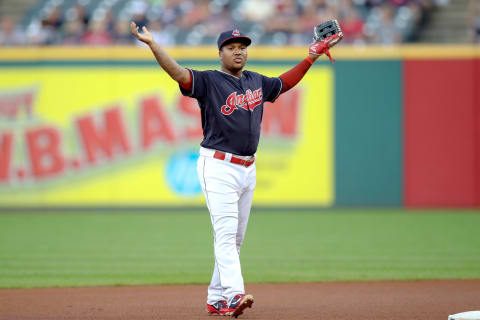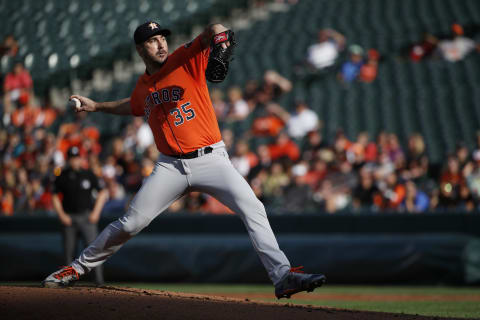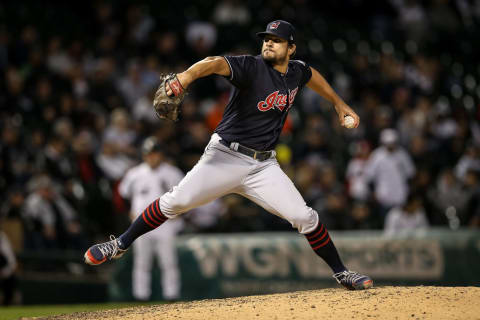MLB Playoffs: 2018 ALDS Series Preview Houston vs. Cleveland


The last two teams to represent the AL in the World Series meet in the ALDS, starting on Friday’s MLB playoffs.
While the Yankees—Red Sox ALDS series is likely to get more media attention, the Astros and Indians series shouldn’t be neglected. No team had an easier run to their division title than Cleveland, who made the MLB playoffs by winning the AL Central by 13 games. As for the Astros, they may not have won 108 games like the Red Sox, but they had the best run differential in baseball and an “expected record” of 112-50, best in the game.
Heading into the season, the AL Central looked to have two main contenders, the Cleveland Indians and Minnesota Twins. The Royals were attempting to compete with some of the players remaining from the core group that won the 2015 World Series, but they ended up losing over 100 games. The young White Sox also lost 100 games and the aging Tigers had 98 defeats.
The Indians got off to a slow start. They were 36-33 and just 2.5 games up in mid-June. A 13-7 streak at the end of June/early July gave them a double-digit lead in the division. Their lead dropped to nine games in early August, but that would be as close as the Twins would get in the second half as the Indians used a 19-9 August to run away with the division.
The Astros were expected to win the AL West easily, but two surprising contenders kept it close for much of the season. First it was the surging Mariners who used their one-run magic to stay close to the Astros well into July. When the Mariners went 31-34 in the second half to fall out of the race, the Oakland A’s shot right past them to put some pressure on the Astros.
The A’s were within 1.5 games as the season turned to September, but a 21-6 record in September by the Astros locked the division away. The Astros finished with the second-most wins in baseball but, as mentioned above, they have an argument for “best team in baseball” status.
The Astros and Indians faced each other seven times this season and all seven games came during a 10-day stretch in May. The Astros won two of three at home, then split two of four on the road. The last time these two teams played each other, Cleveland won on a walk-off home run by Greg Allen against Brad Peacock in the 14th inning.
As the Astros and Indians begin their five game American League Division Series, let’s see how they compare on offense, defense, in the starting rotation and the bullpen.

2018 MLB Playoffs: Astros/Indians Offense
Houston Astros offense: 5th in MLB (110 wRC+)
According to Fangraphs, the Astros had the fifth-best hitting attack in baseball, with a 110 wRC+. This metric takes everything a team (or player) does on offense and adjusts for league and ballpark effects. A 100 wRC+ is league average. The Astros’ 110 wRC+ meant they were 10 percent better than average with the bats. Cleveland also had an above-average offense, checking in at seventh in baseball with a 105 wRC+.
The top Astros hitters are the names you likely recognize—Alex Bregman (157 wRC+), Jose Altuve (134 wRC+) and George Springer (119 wRC+). Bregman led the team in runs scored, home runs and RBI. He has a good chance of finishing in the top five in AL MVP voting. Altuve is the reigning AL MVP, but his offensive production dropped a bit from the last two seasons. Springer was the World Series MVP last postseason when he crushed five home runs in seven games against the Dodgers.
Another player who hit very well, but in less than full time play, was Tyler White, with a 144 wRC+ in 237 plate appearances. White didn’t get called up from the minor leagues until June, but he was a force in June, July and August before slowing down in September.
Shortstop Carlos Correa was having a fine season through June 25, hitting .268/.352/.480 (128 wRC+), but a stiff back that sidelined him for a good portion of the second half seemed to zap his hitting ability. In 153 plate appearances after the injury, Correa hit just .180/.261/.256 for a well below average 45 wRC+. Correa is one of the biggest wild cards in this series. If he isn’t his usual self, the shortstop position will likely be turned over to Marwin Gonzalez, although Alex Bregman played 27 games there this season also.
Cleveland Indians offense: 7th in MLB (105 wRC+)
The top three hitters on the Indians were Jose Ramirez (147 wRC+), Francisco Lindor (130 wRC+) and Michael Brantley (124 wRC+). Ramirez did just about everything you could ask for from a hitter. He scored 110 runs, stole 34 bases, hit 39 dingers, and had 106 RBI. That production earned him the Indians’ nomination for the Hank Aaron Award.
Lindor was also very impressive, with 129 runs scored, 38 home runs and 25 steals. Despite almost exclusively batting at the very top of the order, he had 92 RBI. Michael Brantley bounced back from two injury-marred seasons to have the second-most plate appearances of his career. His .364 on-base percentage was the second-highest mark among Cleveland regulars.
Designated hitter Edwin Encarnacion had 32 long balls and 107 ribbies, but his .336 on-base percentage and .474 slugging percentage were his lowest marks in those categories since 2011. Encarnacion has had four straight years with a declining wRC+, from 151 in 2014 to 115 this season.
The aforementioned quartet of players are the main drivers of Cleveland’s offense, but they can still get some pop from guys like Yonder Alonso (23 homers), Jason Kipnis (18 homers) and Yan Gomes (16 homers).
Another source of power could be Josh Donaldson, who was acquired at the end of August in a trade with the Blue Jays, Donaldson played 16 games with the Indians, hitting .280/.400/.520. That stretch is about equal to what he’d done the previous three years, but his overall numbers for the season weren’t nearly as good.
Speedy outfielder Greg Allen (21 steals) is on the playoff roster. He’ll be joined by a similar player, veteran outfielder Rajai Davis. The team spent some time trying to decide between Davis and infielder Erik Gonzalez and ultimately went with the guy who hit a clutch home run for them in Game 7 of the 2016 World Series. It was one of the biggest moments in Cleveland sports history.

2018 MLB Playoffs: Astros/Indians Pitching
Houston Astros starting pitching: 2nd in MLB (22.5 WAR)
When it comes to MLB starting rotations in 2018, there are the Indians and Astros, then a big gap to the third-best team, the New York Mets. The gap between the Astros, with the second-best starting rotation, and the Mets, with the third-best starting rotations, is about the same as between the Mets and the Braves, who ranked 12th.
With Justin Verlander and Gerrit Cole, the Astros have two AL Cy Young candidates at the top of their rotation. The veteran Verlander is scheduled to start Game 1, with Cole taking Game 2. Verlander led the Astros starting pitchers in innings pitched and ERA. He was 16-9 with a 2.52 ERA and 2.78 FIP. He also had the highest strikeout rate of his career (34.8 percent, which was the best in baseball).
As good as Verlander was, Cole was nearly his equal. He went 15-5 with a 2.88 ERA and 2.70 FIP in 200.3 innings. Cole was third in baseball, with a 34.5 percent strikeout rate. He was everything the Astros could have hoped for when they acquired him in a trade with the Pirates last offseason.
The Game 3 starter for Houston is expected to be Dallas Keuchel, who was 12-11 with a 3.74 ERA and 3.69 FIP in 204.7 innings. He’s the only lefty in the rotation and may have an edge against the Indians, who are about seven percent above average against right-handed pitchers but one percent below average against southpaws.
It’s not yet known who would start a Game 4 for Houston. They could bring Verlander back on three day’s rest or go with Charlie Morton, who was 15-3 with a 3.13 ERA and 3.59 FIP in 167 innings. Morton pitched 112.3 of his 167 innings in the first half because of injuries in the second half.
Cleveland Indians starting pitching: 1st in MLB (22.9 WAR)
The Game 1 starter for the Indians will be Corey Kluber, who has won the AL Cy Young Award in two of the last four seasons, including just last year. Kluber won 20 games for the first time this year and led the team in innings pitched (215 IP, 2.89 ERA, 3.12 FIP). He and Verlander should give fans an exciting pitcher’s duel.
The Game 2 starter for Cleveland will be Carlos Carrasco. After struggling through the first half with a 4.12 ERA and 3.44 FIP, Carrasco came on strong in the second half, with a 2.52 ERA and 2.37 FIP. He increased his strikeout rate by more than six percent in the second half, while keeping his walk rate low.
With Trevor Bauer likely relegated to the bullpen because he’s coming back from a broken leg, Cleveland will send Mike Clevinger out for Game 3. Clevinger may look like the young pitcher from the movie Dazed and Confused, but he knows how to pitch. He had a 3.02 ERA and 3.52 FIP in 200 innings this year.
I laugh whenever @TMo_72 says #Indians pitcher Mike Clevinger looks like Mitch Kramer from 'Dazed and Confused.' pic.twitter.com/DMGpbftKPS
— John Schippman (@JOHNSHIP99) November 2, 2016
Unless the Indians bring Kluber back on three day’s rest, Game 4 will likely go to Shane Bieber. The rookie made his major league debut in late May, then became a mainstay in the rotation in June. As a starting pitcher, he was 11-4 with a 4.25 ERA, but his 2.96 FIP suggests he was more effective than he looked.

2018 MLB Playoffs: Astros/Indians Bullpen and Defense
Houston Astros relief pitching: 3rd in MLB (8.2 WAR)
The Astros had some tough decisions to make when deciding on the make up of their bullpen for the ALDS. Hector Rondon, Chris Devenski, Brad Peacock and Joe Smith didn’t make the cut. Instead, veteran Will Harris and rookie flamethrower Josh James made the roster, along with five others in the team’s seven-man bullpen.
According to Fangraphs WAR, Rondon was the second-best reliever on the team during the regular season. He had a 3.20 ERA and 2.79 FIP in 59 innings. He was much better in the first half (1.94 FIP) than the second half (3.97 FIP), which likely played into the decision to leave him off the ALDS roster. The rookie Josh James has just 7.7 major league innings under his belt but throws hot fire with a 97.1 mph fastball.
The other five relievers will be Roberto Osuna, Ryan Pressly, Collin McHugh, Tony Sipp and Lance McCullers, Jr., who is typically a starting pitcher. Osuna is the team’s new closer after being acquired from the Toronto Blue Jays in a controversial trade just before the trade deadline. Osuna missed half this season while serving a 75-game suspension for violating MLB’s Joint Domestic Violence, Sexual Assault and Child Abuse policy.
Ryan Pressly was also a mid-season trade acquisition. The Astros picked him up from the Twins for two prospects and Pressly was terrific down the stretch. With Houston, he’s pitched 23.3 innings with a 0.77 ERA and 1.49 FIP. Collin McHugh was also impressive in relief this year, posting a 1.99 ERA and 2.72 FIP in 72.3 innings. The lone lefty is Tony Sipp (1.86 ERA, 2.41 ERA in 38.7 IP).
Cleveland Indians relief pitching: 27th in MLB (0.4 WAR)
While both teams have great offenses and the two best starting rotations in baseball, there appears to be a big difference in the caliber of their bullpens. It should be noted that the Indians improved as the season went on, particularly with the additions of Brad Hand and Oliver Perez. In the first half, Cleveland ranked 28th in baseball. In the second half, they were 15th.
The key innings will be handled by Brad Hand, Andrew Miller and Cody Allen. Miller and Allen aren’t the weapons they were the last few years. Miller was limited by injuries this season and had a 4.24 ERA and 3.51 FIP in 34 innings. Allen was even worse, with a 4.70 ERA and 4.56 FIP in 67 innings. He still led the team in saves, but this was by far his worse season. Hand was the best of the three, with a 2.28 ERA and 3.23 FIP in his 27.7 innings with the team.
The rest of the bullpen looks to be Oliver Perez, Adam Cimber and Dan Otero. Perez gives the team a third lefty, along with Hand and Miller. He was very good this year, with a 1.39 ERA and 1.74 FIP in 32.3 innings. He’s the proverbial LOOGY (Left-handed One Out GuY). Cimber is a sidearmer who generates ground balls on 65.8 percent of the balls he allows in play. Otero is a perfectly cromulent right-handed relief pitcher.
Houston Astros defense: 22nd in MLB
Cleveland Indians defense: 8th in MLB
More from Cleveland Guardians
- A guide for Cleveland Guardians fans with eyes on 2024
- Is there a role for Noah Syndergaard with Cleveland Guardians in 2024?
- Cleveland Guardians minor league affiliate hopping on the Tim Anderson fight aftermath
- After Aaron Civale trade, Cleveland Guardians are punting on 2023 season
- Why there’s no reason for Cleveland Guardians to keep Amed Rosario
According to the Fangraphs metric for defense, the Astros ranked 22nd in MLB with the gloves. This is the one area in which Cleveland has an advantage. The Indians’ Yan Gomes graded out better than the main starter behind the plate for Houston, Martin Maldonaldo. Neither Yonder Alonso (Cleveland) nor
(Houston) were very impressive with the leather at first base.
The real advantage for Cleveland is the middle infield and third base, although Josh Donaldson is a bit of a wild card because of his season-long struggles with injuries. Lindor has been much better than Correa in the field this season and both Jose Ramirez and Jason Kipnis are better than Altuve at second base. The outfield is fairly even.
Outlook
With the best run-differential in baseball and an expected record of 112-50, it would seem the Astros have the advantage over the 91-win Indians. That being said, the Indians also had an impressive +170 run-differential, with an expected record of 100-62. They’re better than their 91-71 record. With such good pitching rotations, this should be a low-scoring series, which will bring the bullpen into play. The Astros have the edge there.
dark. Next. How umpires fared on Thursday night
Vegas has Cleveland with the advantage, giving them a 52.5 percent chance to win the ALDS. As it happens, that’s just about the same edge Fangraphs has for Cleveland. ESPN had 27 experts give their prediction and 15 of the 27 chose the Astros. We all know, though, a 5-game series in the MLB playoffs can go in any direction!